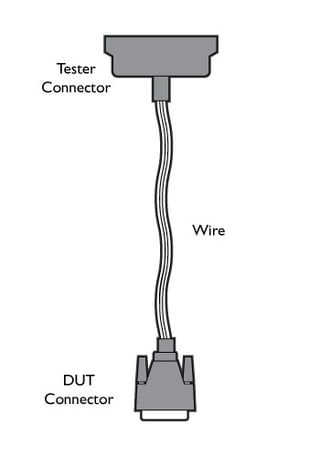One of the biggest challenges in the wire processing industry is lack of consistent definitions. One person may hear the word “Hipot” and think about high voltage testing while another person may think of a specific high voltage test. Fixturing is another word that can mean different things to different people. Here’s what Cirris means when we say “Fixturing.”
What is fixturing?
Cirris uses the word “Fixturing” when referring to the set of wires and connectors that connect the device-under-test to the tester.
This bundle of wires and connectors contains three sections:
- The Tester Connector
- The Wire
- The Device-Under-Test Connector
In order to connect the device-under-test to the tester, you will need fixturing. One end of a fixturing cable will connect to the tester and the other will connect to the DUT. With the fixturing attached, the tester can successfully analyze the DUT for errors.
Is fixturing built or bought?
“This depends on shop rate, expertise in-house, and delivery time.
In shops with dedicated fixture building resources, the work can be accomplished by one person or department. In larger organizations, building fixturing becomes as hard as building high mix and low volume cable assemblies.
Test Equipment companies, like Cirris, see how difficult it is for assembly shops to obtain parts and build fixturing. Many of these high mix low volume test shops produce fixtures. Although the prices can be higher for labor, the savings on this one time setup cost could be worthwhile. If you are price sensitive and have available resources, you can purchase the materials and perform the labor yourself.
For example, Cirris has generic mating cables that only need to be terminated on one end. This can reduce labor and delivery times.”
Via: 5 Questions You Should Ask Yourself About Fixturing
Why care so much about fixturing?
“Fixturing can be a significant portion of the investment in your test system. You need good fixturing to ensure the accuracy of your test results and maximize your test station’s throughput. This means your fixturing needs to be higher quality than the device-under-test. Remember, you want to test the device under test, not test the fixturing.
With so many requirements and specifications, building and maintaining fixturing can feel like an overwhelming burden. While it helps to test your fixturing on a regular basis (shorting blocks and a fixturing test in the wire list is easy and a good practice) there is more you can do to protect your fixturing. Cirris provides a variety of products to help you assemble, operate, and preserve fixturing while saving you time and money.”
Via: 5 Tools to Help with Fixturing
You may use a different word than fixturing, but the next time you talk to Cirris hopefully the communication will be easier. Remember that if you’re ever confused about terminology used by Cirris employees, don’t be afraid to ask what we mean. We want to make sure you have the best experience possible.

Further Reading:
3 Ways to Set Yourself Up for Wiring Errors
Resistance Is NOT Futile
4 Cirris Tools to Save Hours of Time